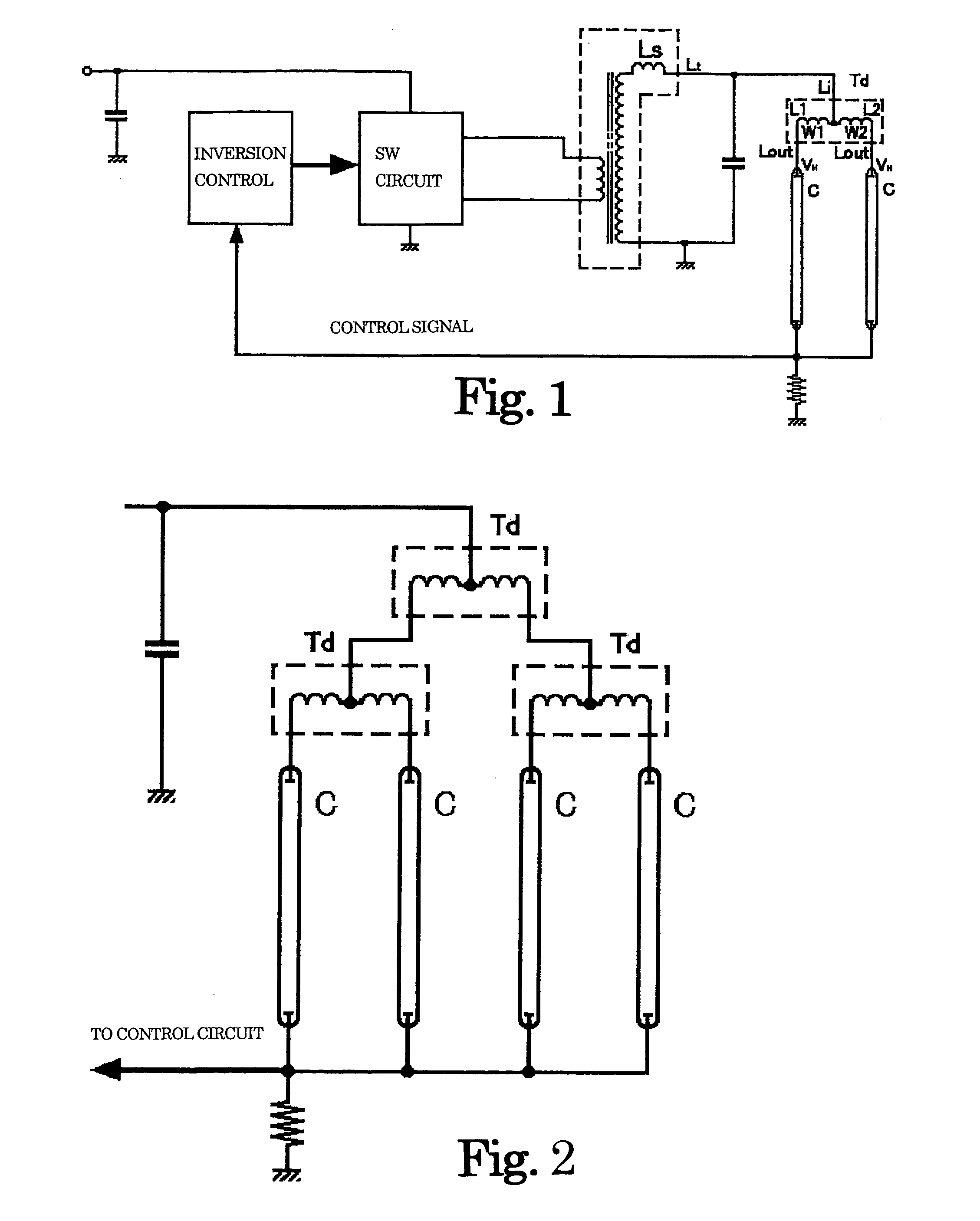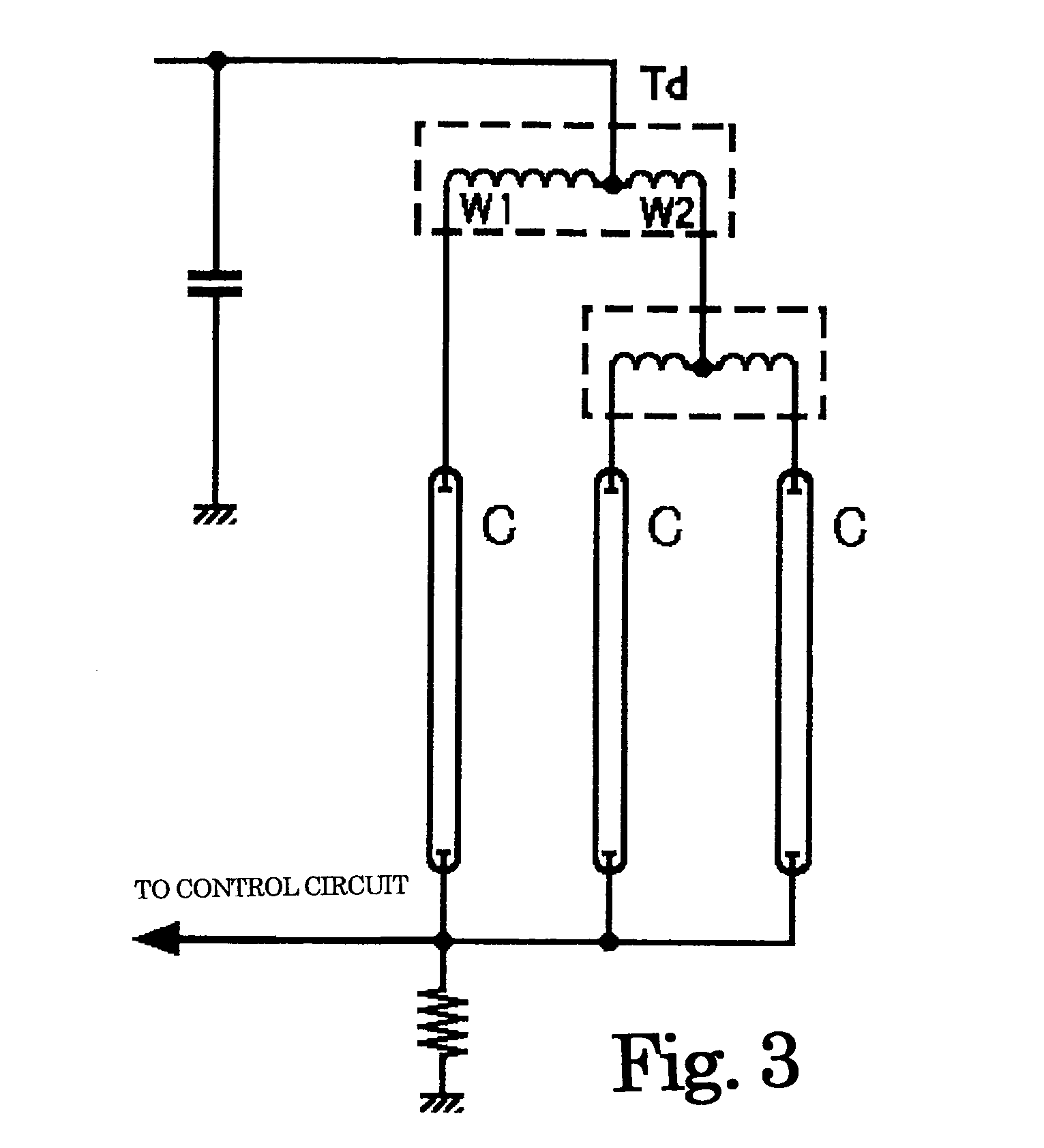Further, the impedance of hot-cathode lamps is very low, and the discharge
voltage thereof is approximately 70 V to several hundreds of volts, which makes it unnecessary to pay much attention to the adverse influence of
parasitic capacitance generated around each discharge lamp.
Further, in this method, when one of the connected hot-cathode lamps is unlighted, an excessive
voltage is generated at a terminal of a current balancer associated with the unlighted hot-cathode lamp, so that when hot-cathode lamps are partially unlighted, there is no other choice but to interrupt the circuit.
Accordingly, the current balancer could not be put into practical use as a single device unless several countermeasures to the problem are taken beforehand.
Moreover, the current balancer itself was conventionally large in size.
However, many of the proposals which have been made are unstable, and no example of practical use has appeared for a long time period since the early days of the cold-cathode
fluorescent lamp.
Further, although the application of the current balancers to cold-cathode fluorescent lamps was experimentally possible, the size of the current balancer was too large for practical use.
Therefore, so long as the
inductance is determined based on the theory, an
inductance value required for the current balancer has to become excessive, and further, the current balancer inevitably has to be made fairly large in outside dimensions.
However, this results in increased distributed
capacitance, thereby causing a decrease in the self-
resonance frequency of the current balancer, so that the current balancer loses its reactance.
This can lead to degradation of current-balancing capability of the current balancer.
As a result, the current balancer cannot properly shunt current so that the imbalance of currents is caused.
However, originally, the negative resistance characteristic of each cold-cathode
fluorescent lamp in the mounted state is not controlled, and hence e.g. when lots of liquid crystals are changed during
mass production, various problems are liable to occur.
Moreover, those skilled in the art have almost no recognition concerning the negative resistance characteristic of the
liquid crystal display backlight.
Further, in the example of the conventional current balancer, saturation of the core, which is caused by imbalanced currents in the current balancer, for example, when one of the discharge lamps is unlighted, is regarded as harmful, and hence the saturation is detected by additionally providing a winding in the shunt transformer, for detection of
abnormality of the circuit.
If
abnormality of the circuit is detected, operation of the circuit is blocked.
When a large number of discharge lamps are to be simultaneously lighted by the conventional inverter circuit for a discharge lamp, the discharge lamps cannot be connected to each other simply in parallel with each other even if they have the same load characteristics.
Further, the
metal ions move along the secondary winding, so that the secondary winding can be sometimes burned due to inter-layer short circuits (layer short circuits) caused by the
metal ions.
That is, the continuous application of a
high voltage to the secondary winding brings about serious problems concerning the service life and management thereof since the above-described troubles occur as changes due to aging of the products after shipping thereof.
In this method, however, it is necessary to provide a leakage flux transformer and a
control circuit for each of cold-cathode fluorescent lamps, which brings about the problems of increases in the circuit size and the manufacturing costs.
In this method, however, it is not possible to control individual electric currents flowing through a plurality of cold-cathode fluorescent lamps connected to a transformer, so that only one current control can be carried out on the primary winding of the transformer.
Further, when there occurs an imbalance between lamp currents flowing through the cold-cathode fluorescent lamps connected to the secondary windings formed as an
assembly, it is almost impossible to make the currents balanced with each other.
Although the above description has been given of the winding transformer, the same problem occurs with an inverter circuit using a
piezoelectric transformer.
Therefore, it is not practical to light a plurality of cold-cathode fluorescent lamps by increasing the step-up ratio, and
shunting electric current into a plurality of cold-cathode fluorescent lamps using the capacitive ballasts.
Accordingly, in general, one
piezoelectric transformer can be connected to only one cold-cathode fluorescent lamp, and hence the use of a piezoelectric inverter circuit has been limited.
When a large number of cold-cathode fluorescent lamps are arranged in parallel for multi-lamp lighting, in most cases, the effect thereof is very unstable, and it sometimes becomes impossible to obtain the
shunting and balancing effects all of a sudden, with a different construction of a backlight or a different type of cold-cathode fluorescent lamps.
Further, in the hot-cathode lamp, in general, there is a large voltage difference between a constant discharge voltage and a discharge starting voltage, and particular operation is required at the start of discharge.
Therefore, the problem of continuous application of a
high voltage to the secondary winding is not alleviated.
However, those skilled in the art have not recognized the necessity of controlling such a negative resistance characteristic from the early days of the
liquid crystal display backlight up to the present time, so that an adequate reactance value that guarantees a stable shunting effect is obscure.
Further, reduction of the size of a shunt transformer based on the excessively set reactance value makes the self-
resonance frequency of the shunt transformer too low, which impairs the effect of reactance related to shunting, so that the shunting effect is lost.
However, the protecting means has no operation or effect of protecting the shunt transformer itself.
Further, the conventional method of detecting
abnormality is based on detection of deformation of the waveform of
magnetic flux generated in the current balancer, and a means of the detection is not simple.
Further, to increase the size of the shunt transformer so as to prevent the saturation of the shunt transformer inversely leads to an increase in core loss caused by the saturation of the shunt transformer.
This has caused generation of a considerable amount of heat.
Furthermore, the cold-cathode fluorescent lamp, which has a high constant discharge voltage, is largely influenced by the
parasitic capacitance generated in nearby associated circuit components and wiring connected thereto, so that if the parasitic capacitances occurring in wiring between an inverter circuit and cold-cathode fluorescent lamps are different, imbalance in currents flowing through the cold-cathode fluorescent lamps is caused.
 Login to View More
Login to View More 


